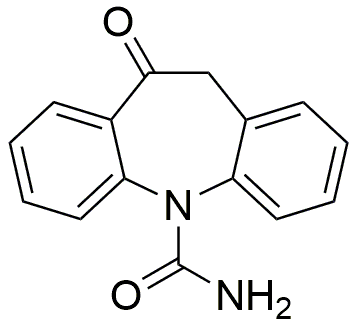Oxcarbazepine is widely utilized in research focused on:
- Epilepsy Treatment: Primarily used as an anticonvulsant medication, it helps manage partial seizures in adults and children, providing an effective alternative to traditional treatments.
- Neuropathic Pain Management: Its analgesic properties make it beneficial for treating nerve pain, offering relief for patients with conditions like diabetic neuropathy or postherpetic neuralgia.
- Psychiatric Disorders: Research indicates potential applications in managing mood disorders, helping to stabilize mood swings in patients with bipolar disorder.
- Drug Interactions Research: It serves as a valuable compound in studies examining interactions with other medications, aiding in the development of safer therapeutic regimens.
- Pharmaceutical Development: Used in the formulation of new drug delivery systems, it enhances the bioavailability of other active ingredients, improving patient outcomes.
General Information
Properties
Safety and Regulations
Applications
Oxcarbazepine is widely utilized in research focused on:
- Epilepsy Treatment: Primarily used as an anticonvulsant medication, it helps manage partial seizures in adults and children, providing an effective alternative to traditional treatments.
- Neuropathic Pain Management: Its analgesic properties make it beneficial for treating nerve pain, offering relief for patients with conditions like diabetic neuropathy or postherpetic neuralgia.
- Psychiatric Disorders: Research indicates potential applications in managing mood disorders, helping to stabilize mood swings in patients with bipolar disorder.
- Drug Interactions Research: It serves as a valuable compound in studies examining interactions with other medications, aiding in the development of safer therapeutic regimens.
- Pharmaceutical Development: Used in the formulation of new drug delivery systems, it enhances the bioavailability of other active ingredients, improving patient outcomes.
Documents
Safety Data Sheets (SDS)
The SDS provides comprehensive safety information on handling, storage, and disposal of the product.
Product Specification (PS)
The PS provides a comprehensive breakdown of the product’s properties, including chemical composition, physical state, purity, and storage requirements. It also details acceptable quality ranges and the product's intended applications.
Certificates of Analysis (COA)
Search for Certificates of Analysis (COA) by entering the products Lot Number. Lot and Batch Numbers can be found on a product’s label following the words ‘Lot’ or ‘Batch’.
Número de catálogo
Número de lote/lote
Certificates Of Origin (COO)
This COO confirms the country where the product was manufactured, and also details the materials and components used in it and whether it is derived from natural, synthetic, or other specific sources. This certificate may be required for customs, trade, and regulatory compliance.
Número de catálogo
Número de lote/lote
Safety Data Sheets (SDS)
The SDS provides comprehensive safety information on handling, storage, and disposal of the product.
DownloadProduct Specification (PS)
The PS provides a comprehensive breakdown of the product’s properties, including chemical composition, physical state, purity, and storage requirements. It also details acceptable quality ranges and the product's intended applications.
DownloadCertificates of Analysis (COA)
Search for Certificates of Analysis (COA) by entering the products Lot Number. Lot and Batch Numbers can be found on a product’s label following the words ‘Lot’ or ‘Batch’.
Número de catálogo
Número de lote/lote
Certificates Of Origin (COO)
This COO confirms the country where the product was manufactured, and also details the materials and components used in it and whether it is derived from natural, synthetic, or other specific sources. This certificate may be required for customs, trade, and regulatory compliance.


